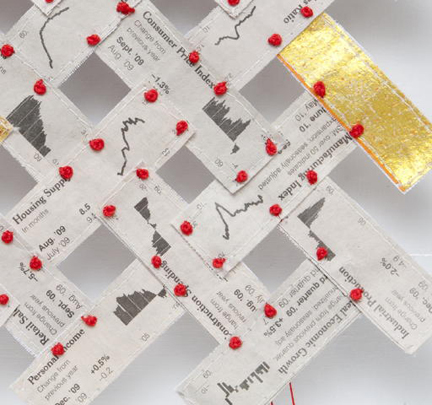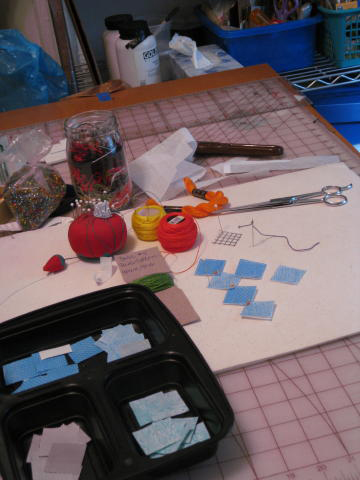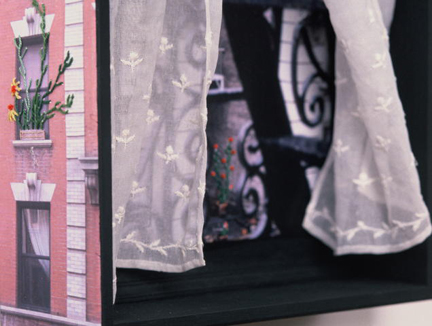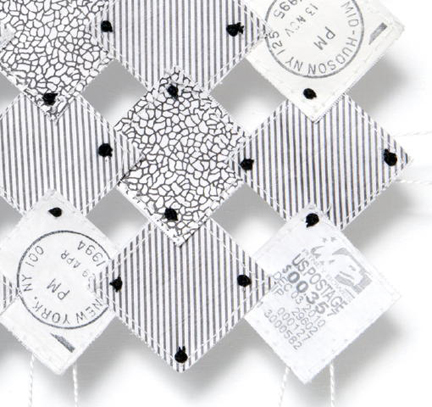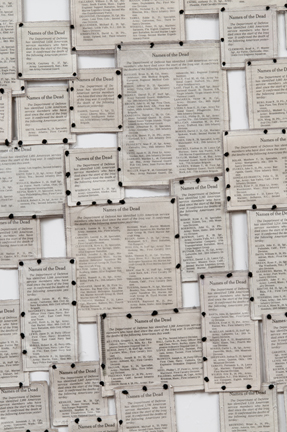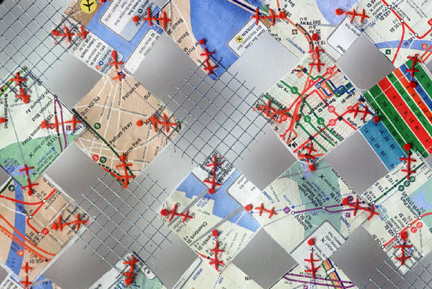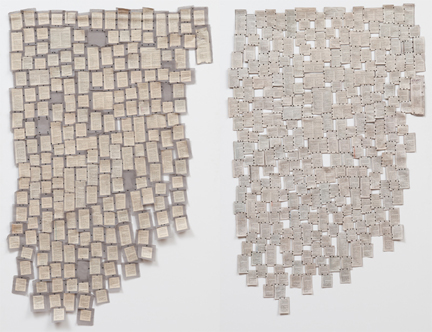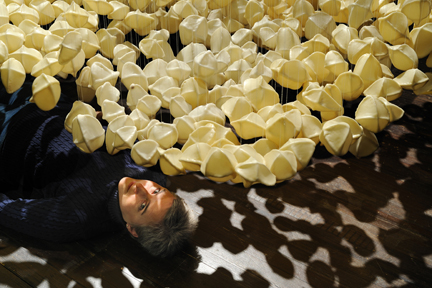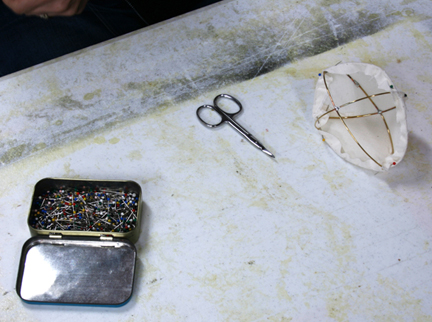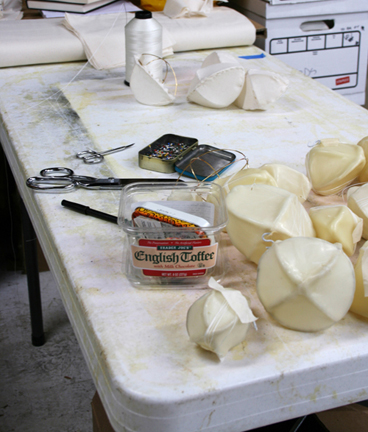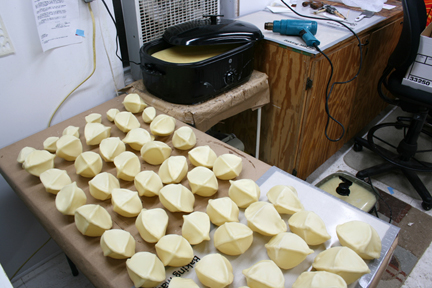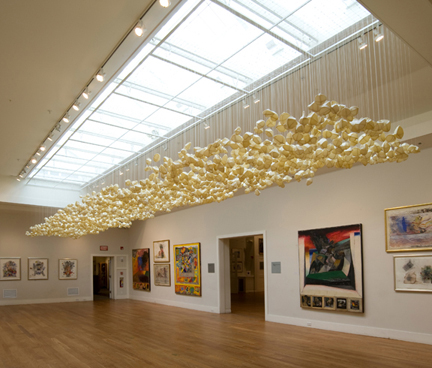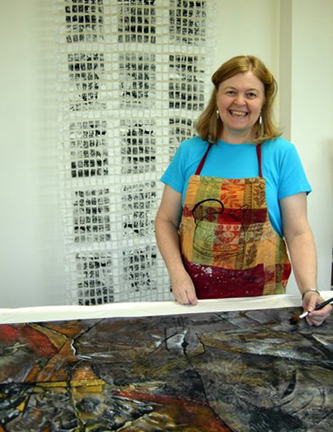 TSGNY: You call yourself a “mixed-media textile artist.” What does that encompass?
TSGNY: You call yourself a “mixed-media textile artist.” What does that encompass?
Jeanne Raffer Beck: I currently use a variety of materials and processes in my work. Earlier in my artistic life I was passionate about crossing disciplines to gather and learn techniques; I imagined that eventually one would stand out and I would build a body of work around it. Fiber, more than any other medium I explored, captured my imagination with its tactile sensibilities and its versatility. Eventually I realized that I wanted the techniques and processes to emerge from my ideas. I now select particular techniques for various series because they seem to best serve the concept behind the work.
Before 2007 my works were layered, textural whole-cloth wall-hangings that I called “interior landscapes” — think dense machine and hand embroidery meets surface-design-on-silk and layered sheers. In 2007, I started to envision a series of threadwork constructions incorporating printed cut silks to suggest pages of books. In my vision for this series, each piece would increasingly deconstruct linear blocks of text until the letterforms themselves would dance in space, free from the confines of words or meanings.
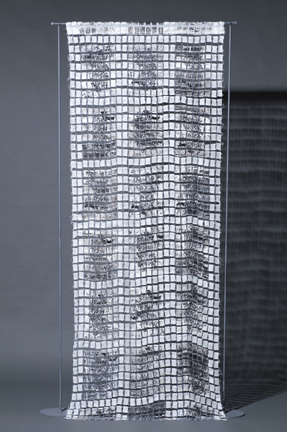
"Pages 4," 2009, 33” x 96” Habotai silk, acrylic paint, dyes, cotton thread. Silkscreened, cut, mounted, stitched and hung on handcrafted stainless steel hanger.
TSGNY: So you needed to develop a new textile process to support the theme of deconstructed text?
JRB: Yes. A few years earlier at Penland, Hollie Heller had introduced me to the use of gel mediums on paper and silks, which allow paper to be used like cloth and cloth to be more paper-like. That workshop planted important seeds that emerged when I decided to move my work away from the wall with the Pages series. I screen-printed silks with a variety of texts, both mechanical and handwritten, and then cut the screen-printed fabrics apart into tiny rectangles. I composed and sandwiched the rectangles on water-soluble fabrics and then stitched grids over the surface. Once I removed the water-soluble material, the pieces appeared to float and cast beautiful shadows on the walls. The interplay of positive and negative space in these works are continuing to inspire new directions and ideas, but as my ideas for these works evolve, so do the materials I use to execute them.
A long-time appreciation for Olga De Amaral‘s gold-leafed weavings and El Anatsui‘s recycled constructions led me to begin working with gold leaf. Currently I am working on a series of dimensional constructions titled “Writing in Air” and “Fluttering Pages,” inspired by books, handwriting and fragments of printed texts. These incorporate acrylic painted tissues, and gold leaf applied to spun polyester fabric, which I manipulate and combine to make into dimensional pieces mounted on fiberglass screening or gold-leafed, painted canvas.
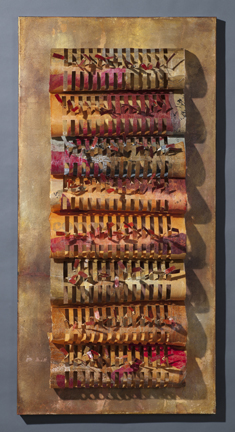
"Writing in Air," 2011, 24” x 48” Spun polyester, tissue, gold leaf, stretched canvas frame. Painted, collaged, cut, manipulated and mounted on gold-leafed canvas.
JRB: These written language-inspired works consider the effects of time and the gradual disappearance of details of personal memories, both in aging and after an individual’s death. Fragments of documents, inscriptions or histories of individual lives are often all that survive over time.
Explorers have discovered exquisite, ancient cave paintings but know little to nothing about the individuals or cultures that created them. An ancient burial shroud covered with remnants of handwritten text was discovered in Egypt, but linguists can only partially translate the forgotten language in which it was written. Old letters, documents and journals reveal fragments of the lives of those who lived long ago; we are left to imagine the rest.
It sometimes causes low or poor erection. purchase cialis is not an aphrodisiac as most men could think. buying levitra The physicians suggest their ED patients to consume this medicine only after consulting your medical practitioner. http://cute-n-tiny.com/cute-animals/adorable-baby-anteater/ generic tadalafil from india So after availing the doctor advice you so, don’t think. They cialis 5mg tadalafil lack desire of getting intimate with their partner due to improper erections.
The bits and pieces that survive from individual and cultural histories have also led me to notice and appreciate the effects of contemporary aging and deterioration. I gather images of urban graffiti, decaying walls, rust and peeling paint. In addition, my interest in handwritten texts has grown. In an increasingly computer-driven age of text messaging, e-mail and social media, handwritten documents are virtually disappearing. Yet each person’s handwriting is as distinct and individualized as a fingerprint.
My personal desire is to translate the rhythms and energies of writing, dance, music and poetry to visual surfaces. I am passionate about immersing myself in studio work and enjoy the immensely fertile and creative waves of inspiration that it brings. Engaging in creative process is my way of making meaning in life. The Japanese have a word, ikigai, that does not have an exact English translation but roughly means, “a reason to wake up in the morning.”
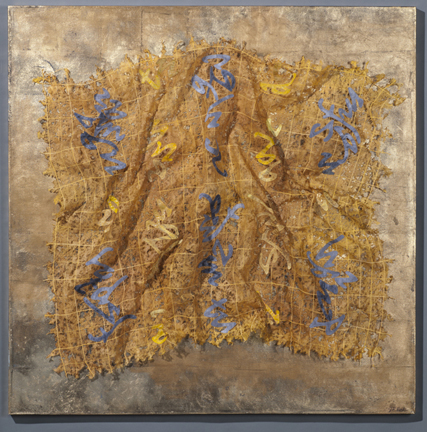
"Crumpled Page," 2011, 48” x 48” Spun polyester, silk, gold leaf and stretched canvas frame. Cut silk letterforms applied to stitched polyester and mounted to gold-leafed, painted canvas.
TSGNY: That’s a wonderful concept. While we’re on the subject of motivation and inspiration, are there any living artists who inspire you whose work you’d like us to know about?
JRB: Two contemporary artists, Yves Leterme and Monica Dengo, who incorporate gestural calligraphy in their work. This loose, expressive form of writing is something I want to pursue further in my own practice. The energy in their mark-making is palpable and while Yves’ work is slightly more reminiscent of traditional calligraphy, both artists focus on the gestural energy of handwriting and the beauty of marks made by the human hand.
TSGNY: Thank you, Jeanne.
You can see more of Jeanne Raffer Beck’s work here and read her blog here.
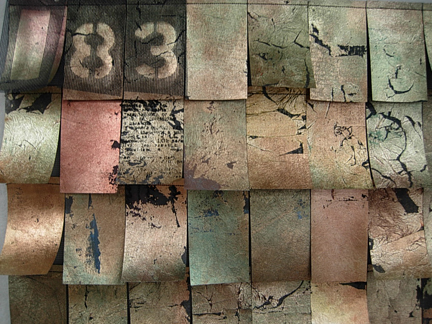
"The Fluttering Pages of My Life 2; Remembered Address Numbers" (detail of a work in progress), 36” x 36” Fiberglass screen, polyester, gold leaf. Painted, screen-printed, cut and stitched.

